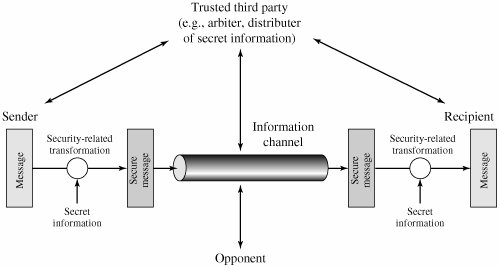Section 1.6. A Model for Network Security
1.6. A Model for Network SecurityA model for much of what we will be discussing is captured, in very general terms, in Figure 1.5. A message is to be transferred from one party to another across some sort of internet. The two parties, who are the principals in this transaction, must cooperate for the exchange to take place. A logical information channel is established by defining a route through the internet from source to destination and by the cooperative use of communication protocols (e.g., TCP/IP) by the two principals. Figure 1.5. Model for Network Security Security aspects come into play when it is necessary or desirable to protect the information transmission from an opponent who may present a threat to confidentiality, authenticity, and so on. All the techniques for providing security have two components:
A trusted third party may be needed to achieve secure transmission. For example, a third party may be responsible for distributing the secret information to the two principals while keeping it from any opponent. Or a third party may be needed to arbitrate disputes between the two principals concerning the authenticity of a message transmission. This general model shows that there are four basic tasks in designing a particular security service:
Parts One through Three of this book concentrates on the types of security mechanisms and services that fit into the model shown in Figure 1.5. However, there are other security-related situations of interest that do not neatly fit this model but that are considered in this book. A general model of these other situations is illustrated by Figure 1.6, which reflects a concern for protecting an information system from unwanted access. Most readers are familiar with the concerns caused by the existence of hackers, who attempt to penetrate systems that can be accessed over a network. The hacker can be someone who, with no malign intent, simply gets satisfaction from breaking and entering a computer system. Or, the intruder can be a disgruntled employee who wishes to do damage, or a criminal who seeks to exploit computer assets for financial gain (e.g., obtaining credit card numbers or performing illegal money transfers). Figure 1.6. Network Access Security Model Another type of unwanted access is the placement in a computer system of logic that exploits vulnerabilities in the system and that can affect application programs as well as utility programs, such as editors and compilers. Programs can present two kinds of threats:
Viruses and worms are two examples of software attacks. Such attacks can be introduced into a system by means of a disk that contains the unwanted logic concealed in otherwise useful software. They can also be inserted into a system across a network; this latter mechanism is of more concern in network security. The security mechanisms needed to cope with unwanted access fall into two broad categories (see Figure 1.6). The first category might be termed a gatekeeper function. It includes password-based login procedures that are designed to deny access to all but authorized users and screening logic that is designed to detect and reject worms, viruses, and other similar attacks. Once either an unwanted user or unwanted software gains access, the second line of defense consists of a variety of internal controls that monitor activity and analyze stored information in an attempt to detect the presence of unwanted intruders. These issues are explored in Part Four. |
EAN: 2147483647
Pages: 209